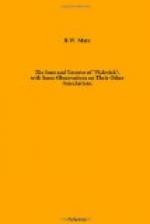Again in 1841 Dickens and Forster passed a day and night in Cobham and its neighbourhood, sleeping at the “Leather Bottle,” and when he ultimately became a resident at Gad’s Hill the whole district was the greatest pleasure to him. His biographer, writing of the year 1856, says: “Round Cobham, skirting the park and village and passing the ‘Leather Bottle,’ famous in the pages of Pickwick, was a favourite walk with Dickens.”
He would often take his friends and visitors with him on these walks, and would never miss the old village inn. W. P. Frith has told us of how, when he formed one of the party on one of these occasions, “we went to the ‘Leather Bottle,’” and, no doubt, the company was merry and reminiscent on the association of the village with the novelist and his immortal book.
The happy thing to be remembered to-day is that neither the village, park, nor inn have changed since those historic days, so that little imagination is required by the pilgrim to recall to his mind the scenes and characters which have made them familiar to lovers of Dickens in every English-speaking country.
CHAPTER VII
The “Town arms,” Eatanswill, and the inn of “The Bagman’s story”
Following the Pickwickians in the sequence of their peregrinations, we become confronted with the problem, “which was the prototype of Eatanswill?” Having weighed the evidence of each of the other claimants for the honour, we favour that of Sudbury in Suffolk, for which so good a case has been presented. That being so, the “Rose and Crown” undoubtedly would be the original of the “Town Arms,” the headquarters of the Blues and the inn at which Mr. Pickwick and his friends alighted on their arrival in the town.
First let us briefly state the case for Sudbury.
In the opening paragraph of Chapter XIII of the book, Dickens writes:
“We will frankly acknowledge, that up to the period of our being first immersed in the voluminous papers of the Pickwick Club, we had never heard of Eatanswill; we will with equal candour admit, that we have in vain searched for proof of the actual existence of such a place at the present day. . . . We are therefore led to believe, that Mr. Pickwick, with that anxious desire to abstain from giving offence to any, and with those delicate feelings for which all who knew him well know he was so eminently remarkable, purposely substituted a fictitious designation, for the real name of the place in which his observations were made. We are confirmed in this belief by a little circumstance, apparently slight and trivial in itself, but when considered from this point of view, not undeserving of notice. In Mr. Pickwick’s notebook, we can just trace an entry of the fact, that the places of himself and followers were booked by the Norwich coach; but this entry was afterwards lined through, as if for the purpose of concealing even the direction in which the borough is situated.”




